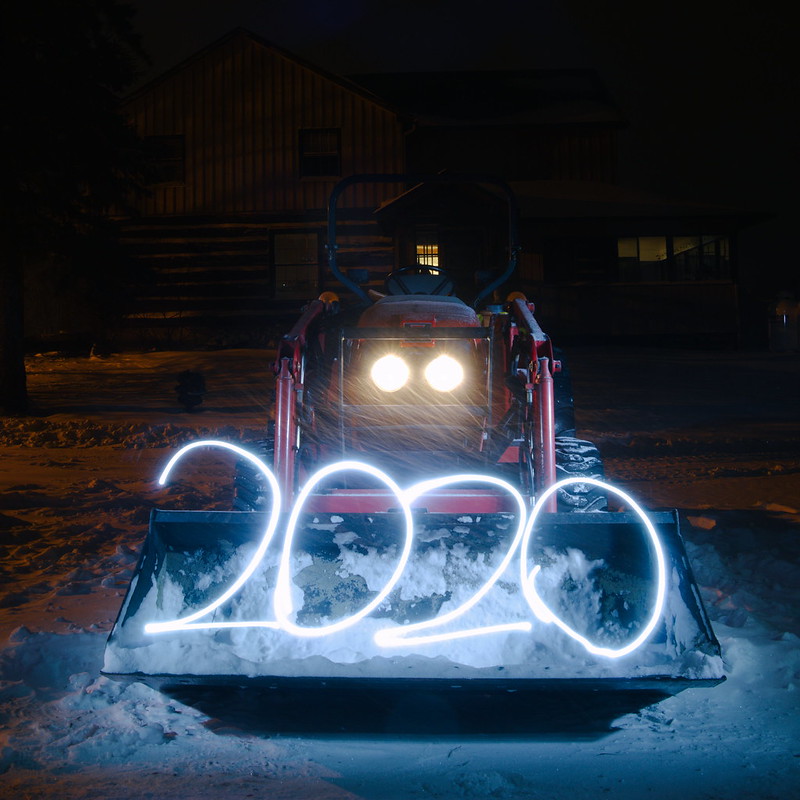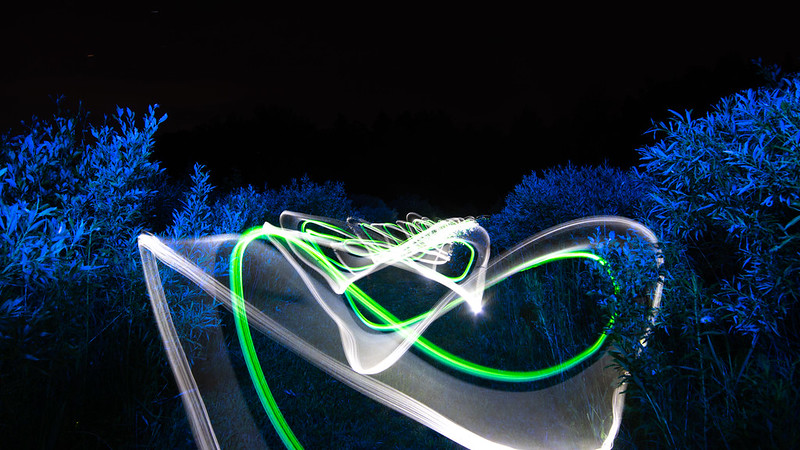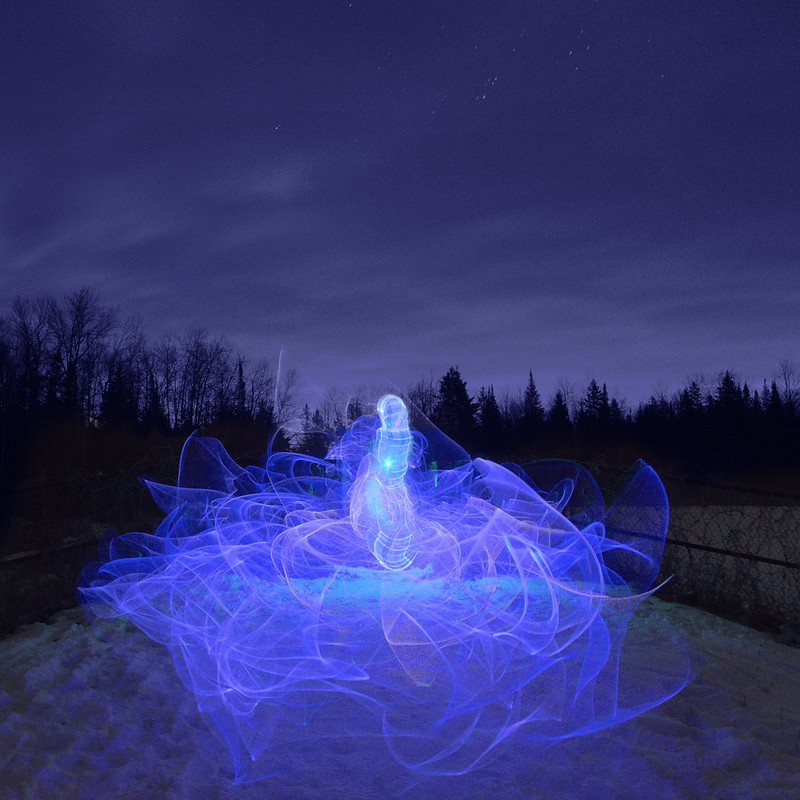Fall 2021 – by Rob Young, reviewed by Scott Elmore
Light painting is a fun and interesting way to make unique images in dark locations. You don’t need much to get started and can create a lot of modifiers with some arts and crafts tools. The basic idea is to create a scene and modify the light with flashlights, flash, or other light sources.
Gear
Required
- Camera – pretty much any camera will work!
- Tripod
- Flashlight. Any will do, a bright flashlight (500 lumens+) lets you run lower ISO and gives you more options, but really you can do this with anything, even a pen light!
Optional Good Stuff
- Dark clothing! Jeans and a black matt hoodie are great, you’re way less likely to show up as an artifact in photos wearing dark clothing
- Light modifiers, diy or comercial (more below)
- Sparklers
- EL wire
- Light bars
- Camera flashes
- Steel wool (CAREFUL, needs a buddy to help watch for fire, a lot of photographers have set things on fire doing steel wool photos)
Ideal Conditions
Light painting is a night time or (very) dark room activity. The less ambient light (street lights, full moon, etc) the easier your job will be, however ambient lighting can also add an interesting dimension to your photo. When first practicing light painting, going somewhere very dark is helpful so you’re not juggling competing light sources.
Night Time Focusing
Focusing at night can be a challenge, but there are a lot of good tips in the link below. Manual focus, or autofocusing and then turning off your auto focus can be very helpful. It’s easy to accidentally engage autofocus when you take your shot and ruin the photo, better to get into the habit of focusing the shot and then making sure your autofocus is turned off.
I’ve found using a flashlight during prefocus is a great shortcut, especially if it’s pitch dark out. You can even put your flashlight on the ground, camera bag, etc, and aim it at your subject. This helps out any focusing aids tremendously.
Bulb Mode is Your Friend
Before we go further, you’ll want to learn how to set your camera to manual mode, or even better, Bulb mode. Light paintings can easily take 5 minutes or more, and most cameras will only measure out manual mode exposures to 30 seconds. Bulb mode will set your camera up to take a photo for an extended period of time.
You’ll want to set the camera up so it keeps the shutter open until you press the shutter again. Some cameras will require an external device (Nikon uses the 25395 MC-DC2 Remote Release Cord), while other brands provide this as a setting. Often by default you need to hold down the shutter for the shutter to stay open, but there are usually ways to change this so you press the button once for shutter open, second press for shutter close.
Don’t use any auto mode, and turn off your built-in on camera flash!
That said, if you don’t have access to this kind of bulb mode, manual mode with a 30 second exposure is great.
Initial Camera Settings
Start with the following settings:
- Bulb Mode
- Self timer (3 or 12 seconds) – this helps with any initial camera shake and generally slows things down, gives you more time to think
- 100 ISO
- f/8 or f/5.6
You can then adjust the settings up or down after taking some practice images.
Image too dark?
Try one or more of the following:
- Increase camera ISO (200, 400, etc)
- Lower f stop (f4, f2)
- Move light slower. By applying more light you can increase brightness
- If light is adjustable, dial up the intensity
Note: if you increase your ISO or lower your f stop, your camera will more quickly pull in ambient light! This can be a challenge on a full moon or street scene. One way to get around this is to take shorter exposures and stack them in a photo editor afterwards. The “lighten” layer mode of photoshop is great for this.
Image too bright?
Try one or more of the following:
- Increase f stop (f11, f16)
- Move light faster
- If light is adjustable, dial down the intensity
Techniques
There are two main ways to light paint, either illuminating your subject with light, or using the light to draw objects in the air.
Illuminating an Scene / Object
Use the flashlight to light up otherwise dark objects. This might take a few tries to find the right amount of light to apply to the object.
- Play with angles of light
- Cause / avoid hot spots by getting closer or farther away
- Use photo gels to create custom light
- You can move around to soften light
Creating Light Objects
The skys the limit! Here are some ideas to start.
Freehand Light Drawing
Simplest technique, and powerful! Move your flashlight / LED bar / EL wire / sparkler through the air to draw shapes, or write words.

Light Orb
You can do this with any kind of light. LED bars or sparklers are good candidates to learn with.
https://www.youtube.com/watch?v=sI8WzSaijCw
Light Painting Brushes Tutorials
The company light painting brushes maintains and incredible list of tutorials on light painting. Some require light modifiers, but many can be done with a flashlight or light bar.
https://lightpaintingbrushes.com/pages/light-painting-tutorials
Light Modifiers
This is anything that modifies the shape of your light. These can be home made or purchased. I like the Light Painting Brushes brand of light modifiers, but I think you could create a lot of these with some creativity, a hot glue gun and some simple materials.
Example of the Process
Below is an example of setting up a shot from start to finish.
- Set up camera on a tripod and conceptualize the shot
- Set the focus. In this case I manually focused to about 6 feet away
- Set camera to bulb mode, ISO 100 f8
- Do some test shots. This involved painting the bushes with a flashlight with a blue bulb, and then using a home made light brush for the main light swirl. I had to play around a bit with my light brightness to figure out good settings and how long to light the bushes
- Adjusted my aperture to f9
- Main shot!
- Adjusted levels in lightroom, darkening the upper section to black and adjusting light levels.

Troubleshooting
Light painting really rewards you being slow and trying one thing at a time, and also rolling with Bob Ross style happy accidents. I’ll often try a scene and figure out one part of it at a time, and then combine them together in the final shot. It’s also often worth doing the same painting a few times. Each shot is unique and often one will stand out!
How Did It Go?
Questions? Want to share some cool shots? You can contact me via one of the social links on https://rjyoung.ca

